Guide to forest bathing
Penned on the 1st October 2021
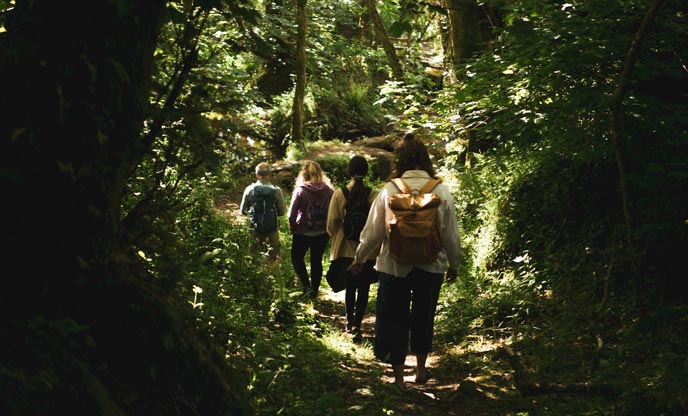
Forest bathing is a practice born from very basic needs: to slow down and feel more; something so fundamental in the fast-paced world we find ourselves in. To better understand what it involves, we spent a morning with Paul Simmons from Forest Bathing Cornwall, who knows the art well and is eager for more people to discover its benefits. This guide walks through our time in the forest and explains how we can all better connect with nature.
The forest invites you to do so much more than simply pass through. With open arms, it welcomes and cocoons you with safe, bellowing trees and a comforting earthy blanket beneath. Its jungle of colours, textures and intricate life provides a playground for the senses. With so much to take in, your mind becomes completely absorbed by nature, gently sweeping any troubles away. The perfect antidote to life’s everyday pressures.
What is forest bathing?
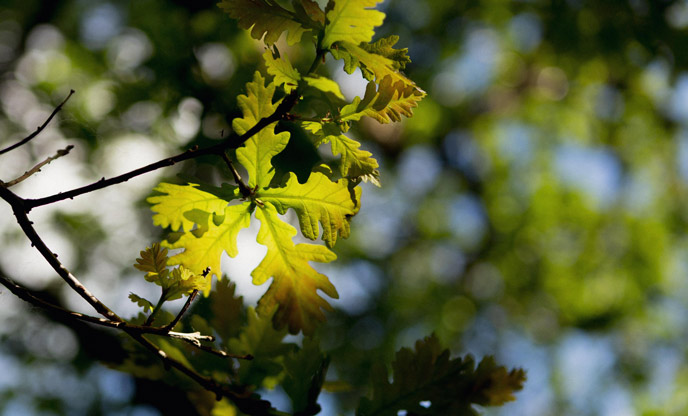
The practice of shinrin-yoku (meaning ‘forest bathing’ or ‘taking in the forest atmosphere’) emerged in Japan in the 1980s as a form of ecotherapy to aid both body and mind. At the heart of it was a simple concept, to reach relaxation by being calm and quiet amongst the trees.
People living in cities were increasingly feeling the effects of tech burnout and stress from overworking, and in search of a solution the Japanese government turned to nature. With over two thirds of the country comprising of vast, dense forest, studies into its health benefits began.
Findings showed that just a couple of hours of mindfulness in the forest could reduce blood pressure, lower stress levels and improve memory and concentration. A chemical released by trees, called phytoncides, was also found to boost the immune system. This provided the science to support what, ultimately, has always been known: that our wild and natural surroundings provide a wealth of benefits to our wellbeing. Put simply, it does us the world of good.
Why try it

While Japan is recognised for coining the term shinrin-yoku, the idea of nature being an antidote is nothing new. The challenge is recognising it, and making time for it amidst life’s distractions. The art of slowing down and feeling more really is that: an art. It’s something many of us have forgotten quite how to do. Life can be so eventful and consuming that, often, we don’t realise the pressures that weigh on us. It’s important to give yourself the time and space to step away from it all and hit reset, and forest bathing gives you that opportunity.
Today there are over 44 accredited shinrin-yoku forests in Japan, and, with advocates like Paul, this form of preventative healthcare is gaining popularity in the UK too. He explains,
‘On top of all the stresses of day to day life there is a tsunami of climate anxiety already upon us and it will only increase. I think it is vital that forest bathing, as one of many nature therapies, is part of a socially prescribed regime to tackle the psychological and physical problems we all face. It is not reinventing the wheel, it is going back to what is in our DNA, a connection to nature which is a natural defense to disease.’
Who is forest bathing for?

Forest bathing isn't just for those who feel at home in the outdoors, it’s for everybody. We’re all designed to be connected with the natural world. Adults and children of all ages feel the benefits of being in the forest. From infant ears listening to the sound of insects going about their work, to adult minds switching off from the humdrum of everyday life; tuning into nature is restorative for each individual.
And if you don’t have access to a forest, that’s ok too. The practice can simply be stepping outside and making a conscious effort to connect with what’s around you. From watching the movement of clouds, to taking in the different scents of wildflowers.
Paul notes, ‘It should start with school, where nature is part of the curriculum. We are nature so we should understand our place within it and be part of it from an early age. Even 30 minutes quietly noticing with all your senses in a park will give benefits that can last for many days afterwards.’
How to forest bathe
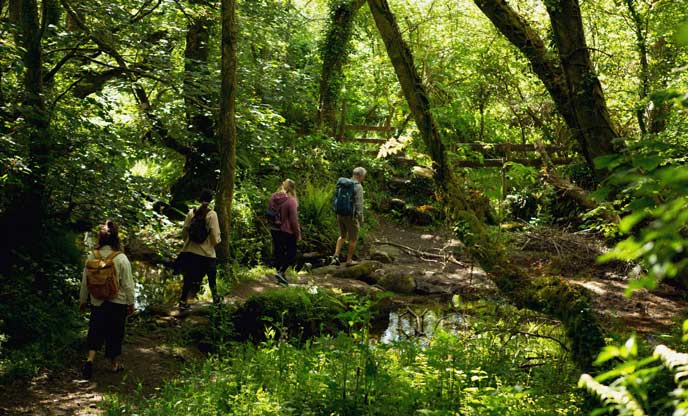
As we set off towards the woodland, it was noticeable from the off that Paul has a strong relationship with the environment. With his arms held out, always, he allows the growth to brush through his fingers as he walks. He has developed an intimacy with his surroundings that has become second nature, instinctive.
If you’re new to forest bathing, going with a guide is a good way to understand techniques that will help you become more present and immersed in your surroundings. During our time together, Paul shared ‘invitations’ to carry out little exercises in the forest. Each designed to reconnect us with our environment; to rediscover the things we’d perhaps forgotten. These can then be taken away to practice alone, or even with friends and family.
‘Just remember to ‘notice’ everything that you are attentive to, from the touch of everything, to the smells and sounds. Do not expect anything to happen and be childlike and intuitive with everything you encounter.’
Engage your senses
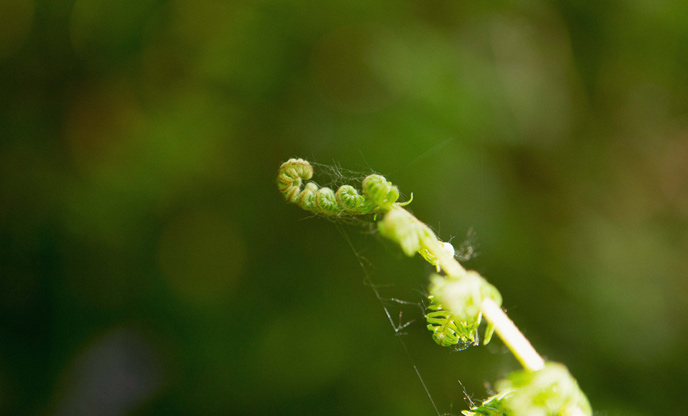
Lots of us spend time outdoors. But is it quality time? Even when you feel like you’re making time to be in nature, the chances are you’re not fully present. So often we are propelled to sweep through, following paths to get from A to B, all the while distracted by the thoughts and demands of daily life.
The first invitation stops you in your tracks and asks you to interact with nature. It involves spending time moving slowly amongst the trees and taking note of what you can see, smell, hear, and feel.
Allow your eyes to feast on the mosaic of colours, constantly changing from one season to the next, dappling light dancing through branches, called ‘komorebi’, and a sea of bark. Smell the sweet and woody fragrance of ferns, especially when the rain has fallen, and listen to the mellow hum of wildlife, constant and reassuring. Leaves rustling in response to the wind.
And then there’s that all-important, yet often redundant sense: touch. As you explore the greenery with curious hands, you might just be transported to childhood memories. Sticky plants that cling to your clothes from running through head-high growth; droplets on your skin from moving through hanging branches, eager to discover hidden alcoves.
It’s said that forest-bathing can have that effect, a particular smell or sound can take you to another time and place, release a memory, or ignite a feeling. It can also have the power to completely change your mood. And that’s the beautiful thing about stirring your senses, you never know where it will take you and the benefits it can have.
Welcome flow
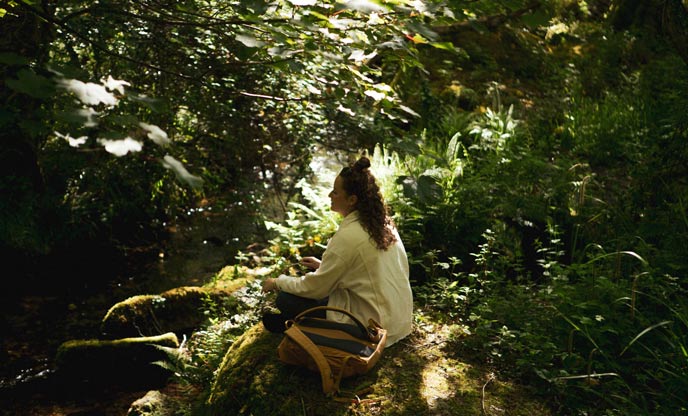
Alongside the abundant benefits of ‘green space’ on wellbeing, experts have also delved into the effects of water on us - determining that being in or simply near water can have an instant calming effect on the mind. Blue mind science (or the blue gym) suggests that contact with water induces a meditative state that makes us healthier, happier, calmer and even more creative, and that the effects can be felt in a variety of settings, from being close to the ocean, a river or lake, to a swimming pool or fountain.
The second invitation draws on our innate connection to water, and seeking running water in the forest, we each found a quiet spot to sit next to it. Watching and listening to the gentle, or rapid, flow of water detoxifies your mind, washing away any problems in the same way it moves over the earth, purifying its path. The science says that flowing water increases the number of negative ions in the air which refreshes you and gives you mental clarity. An office might have 100/cm3 whereas a waterfall could have 100,000/cm3.
To add to the experience: try holding a leaf, or piece of fallen flora, and think of a challenge or issue that you want to overcome or let go of. Then send it away into the water.
Focus on the detail

Bringing your awareness to what’s immediately around you is key in forest bathing. By guiding your mind to what’s present in the here and now, other thoughts and worries are pushed aside, forgotten. It gives your mind the space and clarity it needs to feel cleansed and rested.
For our last invitation in the forest, Paul took us to a more densely wooded area, packed with ancient trees, both strong and fallen, large patches of ferns, and leafy paths leading to different nooks amongst the trees. Here, we each chose a spot to take root for some time. To sit, completely still, and focus on a very small area of the forest.
This awakens your mind’s eye to investigate the details present in nature. While, in many elements of life, the bigger picture can be overwhelming, this is a useful reminder that you can take just one part of it and start from there. Pinpointing roughly the size of a polaroid and making that your subject, look at the intricate details, colours, textures and patterns of that small but impactful pocket of life. The tiny fragments of pearly green lichen, clinging to a fallen bark - where old meets new and where life persists in unlikely places. It encourages you to find beauty - and peace - in simplicity.
Tips for forest bathing

- Switch off your devices, or leave them at home. This gives you the best opportunity to enjoy a sensory experience without any disruptions from technology.
- Move slowly through the forest to allow your senses to absorb what’s around you. Resist the urge to cover more ground, and instead concentrate on a small area.
- Use all of your senses to experience the forest, and try to connect more with those that you might not often use, such as touch. Take notice of how the forest makes you feel and how it affects your mood and thoughts.
- Take long, deep breaths into the abdomen. Slowing down your breathing while opening up the airways tells your body that you’re welcoming a state of relaxation.
- Sit quietly and still, and try not to think about life beyond the forest and nature. Give your mind the space it needs to rejuvenate.
- Stay as long as you can to achieve the best sensory forest bathing experience. Two hours is recommended, though the benefits can be felt from as little as 15 minutes. Do what feels comfortable, and build up the time you spend practicing this mindfulness.
- Try to incorporate forest bathing, or simply using these techniques to better connect with nature, into your routine and lifestyle more. This type of preventative healthcare should be actively used to boost your wellness and combat the onset of ill health.
- Invite friends and family to try forest bathing too. Though, if you decide to go together, make sure you take time for yourself and resist talking until after the experience.
- Take items that make you feel comfortable, such as a mat for sitting on or blanket if it’s chilly. Plenty of water, and tea for a more meditative experience, is recommended too.
- Choose quieter times to visit the forest or natural spaces, such as early in the morning on the weekend, or a weekday afternoon.
Bathing in nature
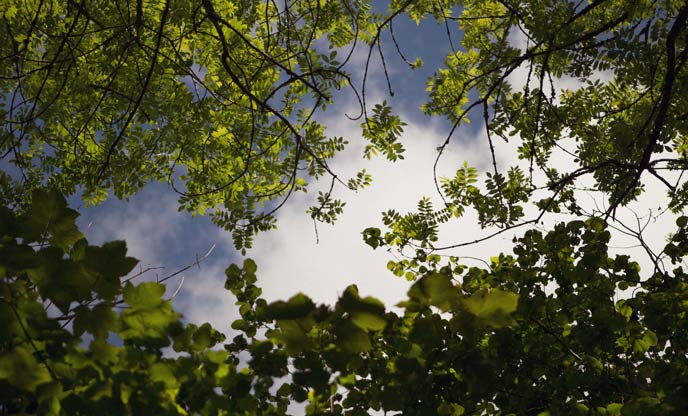
After leaving the forest, Paul made an impromptu suggestion to enjoy a spot of cloud bathing before finishing the session. So we each found a comfy spot in a grassy field, and bedded down for about twenty minutes or so.
Observing the movement of clouds works wonders in occupying your mind, keeping the usual hustle and bustle of life at bay for a while longer. It also serves as a reminder that you can immerse yourself in nature wherever you are, not just the forest. Simply find a quiet spot if you can, and use your senses to hone into your natural surroundings.
Lastly, remember that forest or nature bathing of any kind is not intended to be exercise, its aim is to promote slowness and a greater sense of mindfulness. Shinrin-yoku is the bridge so many seek to better connect us with the natural world. To find comfort, energy and vitality from its fruits. To learn more about forest bathing and its benefits or to try it for yourself, contact Paul here.